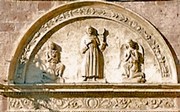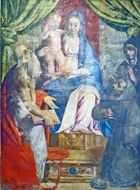

Sant’ Antonio Abate (12th century)
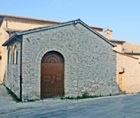
Sant’ Antonio Abate then passed to the Capuchins. They used some of the marble slabs that originally covered the surface of the Roman mausoleum to construct the adjoining convent.
The Capuchins were forced to leave the adjoining convent in 1867 and were re-established at the Oratorio dell’ Immacolata Concezione (below) in 1881. The ex-church now belongs to the nearby Convitto Nazionale (a school).
Madonna and Child with saints (1599)
-
✴one in 1596 for a signed panel of the Madonna and Child in glory with six saints, which has been lost; and
-
✴a second in 1599.
This second payment has been associated with this panel from the church, which is now in the Pinacoteca Comunale. It depicts the Madonna and Child with SS Jerome, Francis and Clare.
San Bernardino (1472)
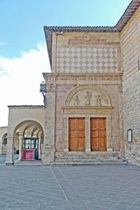
Relief (1488)

San Feliciano [date ???]
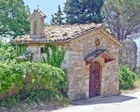
San Francesco Piccolino (13th century)
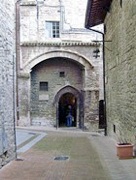
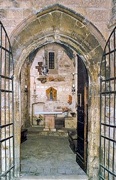
This oratory was first documented in 1286. Since the early 14th century, it has been venerated (somewhat improbably) as the stable next to the house in which St Francis was born.
The damaged frescoes (14th century) under the window on the altar wall (visible in the photograph above, on the right) were rediscovered when the oratory was restored in 1926.
Santa Margherita (13th century)
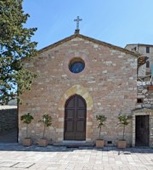
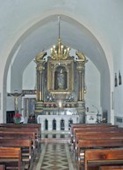
This small parish church was first documented in 1246.
Its interior has been completely remodelled.
Santa Maria della Immacolata Concezione
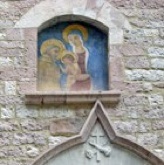
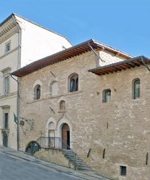
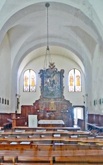
This oratory passed to the Capuchins in 1881 after they were forced to leave Sant' Antonio Abate (see above). The arms of the Observant Franciscans (the stigmatised hands of Christ and St Francis flanking a cross) are in the keystone of the portal, with a fresco(19th century) of the Madonna and Child appearing to St Francis.
The interior is in the form of a simple, cross-vaulted room. The altarpiece (19th century) depicts the Immaculate Virgin.
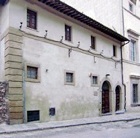
San Rufino in Arce (late 12th century)
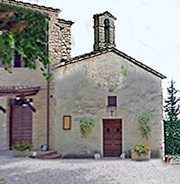
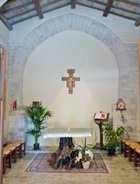
According to a legend published in 1654, St Rufinus of Arce was a young cleric who refused to perjure himself in defence of a priest charged with bad behaviour. He was thrown into a well at Arce, at the foot of Monte Subasio. Monks from the Abbazia di San Benedetto al Monte Subasio saw a light coming from the well and, when they investigated further, found the body. They retrieved it and built this church on the site. The feast of this saint is recorded in the late 12th century, so these events must have occurred before that time. [The well in which was martyred is in the courtyard in front of the church.]
This church was documented in 1217 as a possession of the canons of San Rufino in Assisi. It is sometimes said that it formed part of the leper hospital of San Lazzaro in Arce, but this is probably incorrect.
A document in the Cathedral archives records that the relics of St Rufino of Arce were “recognised” in 1571 and translated to a new altar in San Rufino in 1586.
The church was restored in 1995-7, when the adjacent farm buildings were adapted as a nunnery for the Suore Missionarie Francescane di Susa.
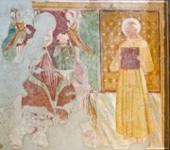
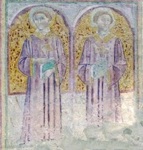
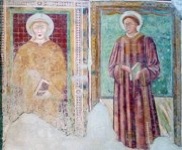
The restoration of the church uncovered frescoes (15th and 16th centuries), which include depictions of:
-
✴the Maestà (damaged) with St Bernardino of Siena, on the right wall;
-
✴a pair of deacon saints, also on the right wall; and
-
✴another pair of deacon saints, on the left wall.
San Salvatore delle Pareti (12th century)
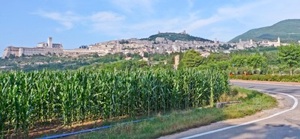
This church and hospice, stood in Via Ospedale delle Pareti, outside Assisi (at the point from which this photograph was taken), was documented in 1193 and again in 1198. It belonged to the Fratres Cruciferi. (Pope Alexander III approved this order in 1169, and it had about forty houses dedicated to the care of lepers in Italy and the Holy Land by the early 13th century).
This site was near the other early Franciscan settlement at Santa Maria della Portiuncula (later Santa Maria degli Angeli). This probably explains how St Francis made the acquaintance of one of the Cruciferi, a man named Morico. When Morico fell ill, St Francis sent him a remedy that cured him, and he became one of the early followers of St Francis.
It is sometimes claimed that this hospice was a leper hospital at the time of St Francis, although no early source for this information is known. The earliest such assertion seems to be in “Lo Specchio de l’ Ordine Minore” (otherwise known as “La Franceschina”), which was published by the Observant Franciscan Giacomo Oddi of Perugia in ca. 1474. However, he probably based his account on the fact that, at the time that he was writing, the hospice next to San Salvatore was used for victims of plague.
The complex passed to the friars of Sant’ Agostino, Perugia in 1505, despite the objections of the Franciscans of Assisi. The Gualdi family bought it in 1873, and adapted the convent as Villa Gualdi.
Return to Monuments of Assisi.
Return to Walk I (Sant’ Antonio Abate).
Return to Walk II (San Feliciano; and San Francesco Piccolino).
Return to Walk III (San Bernardino; Santa Margherita;
and Santa Maria della Immacolata Concezione).
Return to “Around Assisi” (San Rufino in Arce; and San Salvatore delle Pareti).
Return to the home page on Assisi.
